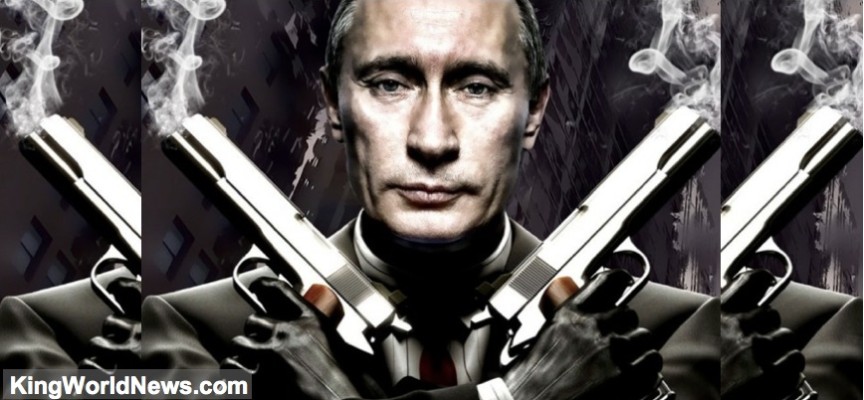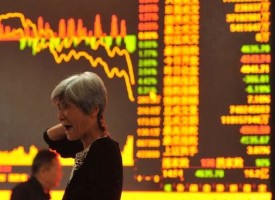Russia is winning decisively in Ukraine and it is impacting the world.
June 27 (King World News) – Stephen Leeb: The war in Ukraine has further solidified the division of the globe into two parts. For convenience’s sake, these can be labeled North/West (NW) on the one hand and South/East (SE) on the other. (Clearly, this geographical shorthand is somewhat arbitrary – for example, if Mexico’s northern border delineates the top boundary of the South, then Russia would lie mostly in the North – and you could similarly place Russia in both the East and West.)
The NW, which of course includes the U.S., has vast financial wealth – but lacks sufficient natural resources to continue to maintain that wealth. The SE is poor in financial wealth – but rich in all the critical natural resources and materials the NW needs.
These disparities make it essential for the NW to build bridges to the SE, something that will require diplomacy and a clear-eyed willingness to cooperate with countries around the world. If we don’t recognize this in time, the NW will likely end up with the short straw. We simply don’t have the luxury of arguing the NW represents values such as goodness, fairness, and freedom. Yes, these are values that we should cherish. But in today’s world, after 50 years of a gradual and lately accelerating slide, they resemble meaningless slogans that don’t acknowledge the actual shape of today’s world.
For investors, the disparities continue to mean that real assets – natural resources led by gold and silver – should be central to where you put your investment money.
Perhaps the most significant thing to realize is that Russia makes all the difference in how the sides match up. Consider two sets of countries: the G7 for the NW bloc and, as recently christened by Russia, the G8 for the SE bloc. The G7 consists of the U.S., Japan, Germany, Britain, France, Italy, and Canada. In the G8 corner are China, India, Russia, Indonesia, Brazil, Mexico, Iran, and Turkey. (If you’re surprised by Mexico, you may have missed the recent comment by Mexican President Obrador that the war in Ukraine was an immoral conflict in which Ukraine’s supporters are supplying the weapons and Ukraine is supplying the dead.) It should be emphasized, too, that today’s G7 itself used to be the G8 in a grouping that included Russia.
Evidence of the divergence between the two halves is pervasive. Take the stock market, for example. As the chart shows, real assets, as represented by an ETF that tracks future prices in all major commodities, are following an entirely different trajectory from financial assets as represented by the S&P 500.
Since the start of the year, the commodity ETF has gained about 33% while the S&P 500 has declined about 18%. Interestingly, during the recent correction in commodities, which to date is a bit more than 8%, the downward path of the S&P 500 corrected upward, so far by just 3%.
The Ukraine war has made some things clear to both blocs. Most obvious is that U.S. sanctions have proved worse than useless. In a world of fundamental resource scarcities, money means a lot less than it used to. I have long argued that resource scarcities were accelerating and would lead to a crisis sooner or later. The war in Ukraine and the astonishing lack of perspicacity by NW countries have meant sooner has arrived faster than I thought possible. Sanctions coupled with a European response that in some cases has been unfathomably stupid have brought Europe to a major crisis point.
If you think this is too harsh, consider that one reason the energy crisis in Europe is so acute is that an essential pipeline for delivering natural gas needs repair. According to Reuters, the only company that can make the repairs is the German company Siemens, and for various reasons the repairs have to be done in Canada. But Canada’s finance minister (who has Ukrainian ancestry) is being a stickler about the sanctions. So Siemens is blocked from sending anything from Canada to Russia. Since Siemens, like many good European corporate citizens, is winding down its relationship with Russia, it has become a real question as to how and when repairs will take place. And this is hardly a one-off example.
As a result, Germany is rationing gas. And while Germany is the NW country most directly affected by energy shortages, others are experiencing four-decade highs in inflation, which in turn are having major political consequences. Recent elections in France left Macron, the presumed successor to Merkel as Europe’s leader, with severe parliamentary losses that could impede any legislation he proposes. Italy, Spain, and Great Britain also face potential turnovers in their governments.
It hasn’t surprised me that the sanctions have backfired in such dramatic fashion – given the resource scarcities I’ve been writing about, I expected it right from the start. More surprising to me has been how ineffective the U.S. and other Western countries have been in their military support of Ukraine. The U.S. has poured more money into the Ukraine war effort than the entire Russian yearly defense budget. Yet barring a massive surprise, the biggest question is not whether Russia will prevail. It’s whether it will choose just to take over Ukraine’s East, leaving western Ukraine as a landlocked country without its prized and in today’s world priceless farmland – or, alternatively, to ensure that Ukraine never joins NATO, also goes after key centers in the Western part of the country…
To find out which gold & copper explorer just hit significant mineralization click here or on the image below

I have been writing about America’s slide for more than a decade, including in my past two books and in many articles. But I have always assumed America’s military was still leading the pack, even as China built up great defensive capabilities. The war in Ukraine, though, raises some serious doubts about U.S. military capabilities. My source for this depressing observation is Rusi, which is short for Royal United Services Institute. Founded by the Duke of Wellington (Napoleon’s conqueror), it’s the world’s oldest and probably most trusted military think tank. In a June 17 report commenting on Ukraine’s surprisingly poor performance, Rusi noted:
The rate of ammunition and equipment consumption in Ukraine can only be sustained by a large-scale industrial base. This reality should be a concrete warning to Western countries, who have scaled down military industrial capacity and sacrificed scale and effectiveness for efficiency. This strategy relies on flawed assumptions about the future of war, and has been influenced by both the bureaucratic culture in Western governments and the legacy of low-intensity conflicts. Currently, the West may not have the industrial capacity to fight a large-scale war. If the U.S. government is planning to once again become the arsenal of democracy, then the existing capabilities of the U.S. military-industrial base and the core assumptions that have driven its development need to be re-examined.
The report also notes that the number of shells and missiles the Russian soldiers use in days exceeds what the U.S. produces in a year, while in the past four months the Russian have used more cruise missiles that the U.S. produces in several years.
Clearly the NW, G7, or just the West, whatever name you want to use to refer to countries headed by the U.S., needs to get serious about cooperating with the rest of the world or else prepare to face a ton of pain. The reckless worship of money and short-term gains can last only so long. After half a century of it, we need to return to the recipe that worked so well in the wake of the Civil War and more recently WWII.
I’ll have more to say in the future about some of the calculations and miscalculations by the U.S. and our allies with respect to Ukraine and more generally to Russia and their implications. One thought I’ll end with is that in the recent instances where the U.S. has essentially gone to war, including in Iraq and now in supporting Ukraine, it has involved resource-rich countries. In the end, the best way to make sense of our actions may be that we went after Russia for the very reason Russia has been beating us so badly in the Ukraine – its massive endowment of natural resource – betting that Putin would fall and that we’d gain greater access.
But Putin’s alignment with the other countries in the new G8 of SE countries, countries that aren’t going along with the NW’s sanctions, has thwarted that outcome. The only viable path for the U.S. and NW is cooperation. Meanwhile, investors will continue to face massive volatility, but regardless of what path we take, commodities including precious metals will be essential to the world and to your portfolios.
Also of importance…
Eric King: “Adam, AngloGold acquired Corvus for almost half a billion dollars (Canadian), and your company recently sampled over 23 grams of gold in that same district.
Adam Melnik: Yes, Eric, we are absolutely stoked about the Beatty mining district. We’ve got a dominant land package and we are ready to start hitting that with a drill next month. You referenced the AngloGold acquisition for almost half a billion dollars. There has been another recent acquisition by Richard Warke at Augusta. He just bought another 300,000 ounces of gold across the way and plans to be in production there in a couple of years.
So we’ve got a major company investing in development exploration that will soon be in production just to the north of our property, and we’ve got a mid-tier that is an absolute rocket ship that’s going to be in production in the next two years as well. So the Beatty district is really hot, Eric. And making a major discovery at our Bullfrog project right in the heart of the Beatty district with the presence of Anglo Gold, Augusta Gold, Coeur Mining, and Kinross, is a very clear pathway to value creation for our shareholders.
Our near-term goal is to make a large discovery at our two precious metals projects in the Beatty district of Nevada and in the Boise basin of Idaho, and crystalize that value and minimize dilution for our shareholders. We are very proud of our properties and projects within the Copper Triangle of Arizona. We just finished a drill program at Red Top, which is right next to Resolution, one of the world’s largest undeveloped mines that should boost America’s copper production by roughly 25%. The fact that we hit a major system in our very first drill hole at a tricky porphyry target is testament to our team’s technical abilities and I’m very proud of what we’ve accomplished there to date.
We look forward to a subsequent phase of drilling at Red Top as well as the drilling that is scheduled take place at our Bullfrog project. So we will be generating an immense amount of news flow and catalysts for our investors and we have the right team to deliver value for our company. Zacapa Resources, symbol ZACA in Canada and ZACAF in the US.
***To list to James Turk discuss what to expect as the hangover begins from the bursting of the global everything bubble as well as what to expect next for gold and silver CLICK HERE OR ON THE IMAGE BELOW.
© 2022 by King World News®. All Rights Reserved. This material may not be published, broadcast, rewritten, or redistributed. However, linking directly to the articles is permitted and encouraged.








